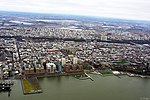Edwin A. Stevens Hall
Buildings and structures in Hoboken, New JerseyNational Register of Historic Places in Hudson County, New JerseyNew Jersey Register of Historic PlacesNew Jersey Registered Historic Place stubsSchool buildings completed in 1870 ... and 2 more
United States history stubsUniversity and college buildings on the National Register of Historic Places in New Jersey

Edwin A. Stevens Hall is located in Hoboken, Hudson County, New Jersey, United States. The building was added to the National Register of Historic Places on February 4, 1994. The building was designed by Richard Upjohn and built in 1870. The building was named after Edwin Augustus Stevens and used as the main building for the Stevens Institute of Technology. The renowned DeBaun Auditorium, which is over 100 years old, is located in this building. The building is currently used as the Charles V. Schaefer, Jr. School of Engineering and Science.
Excerpt from the Wikipedia article Edwin A. Stevens Hall (License: CC BY-SA 3.0, Authors, Images).Edwin A. Stevens Hall
4th Street,
Geographical coordinates (GPS) Address Nearby Places Show on map
Geographical coordinates (GPS)
| Latitude | Longitude |
|---|---|
| N 40.742222222222 ° | E -74.033495833333 ° |
Address
Our Lady of Grace Church
4th Street
07030
New Jersey, United States
Open on Google Maps









